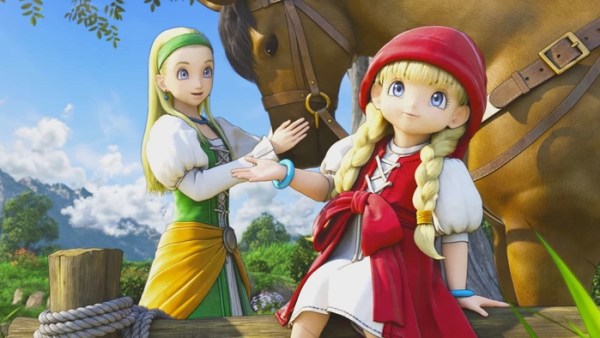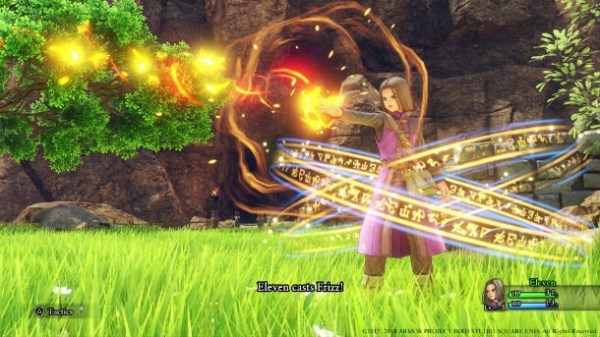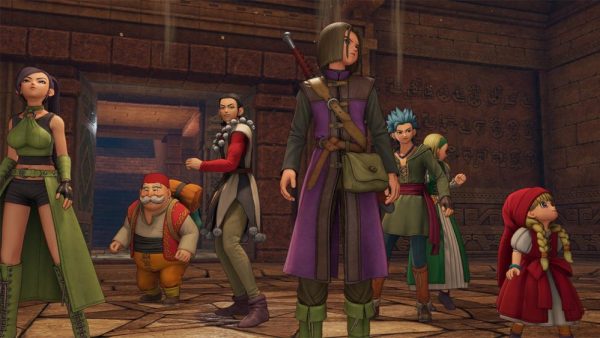Dragon Quest XI: Echoes of an Elusive Age on PS4
We last saw the release of a mainline Dragon Quest game in the west eight years ago, with Dragon Quest IX on DS. Since then JRPGs have changed dramatically and new entries in famous franchises have made big changes, a la Final Fantasy XV, Persona 5, and Monster Hunter: World. Dragon Quest XI: Echoes of an Elusive Age may not be the radical change those aforementioned games were, but what it does end up being is a traditional JRPG for the modern age, one that implements enough modernization to feel fresh, but somehow manages to capture the quirk and charm that the beloved JRPGs of the 90s did. It’s a massive engrossing game and a journey that I honestly didn’t want to end.
Dragon Quest has always been about using a typical JRPG storyline, heck it even helped invent JRPG tropes, and Dragon Quest XI is no different. You play a young man growing up in the village of Cobblestone, who one day finds out he’s the prophesied hero known as the Luminary, destined to fight off the forces of evil and the Lord of Shadows. As monsters and villainous creatures appear around the world, you set off from your hometown to the capital of Heliodor, but what awaits you there spurs you to go on a lengthy journey across the world.
The story in Dragon Quest XI is a prime example of being about the journey and not the destination, as the little stories that happen along the way make up the true heart of the game. While the main villain himself is fairly forgettable personality-wise, his actions certainly aren’t. Because of this, the lack of a fleshed out villain isn’t necessarily a problem, as the Lord of Shadows does at least a good job of pushing the heroes onward and giving them a cause to fight for.
Dragon Quest XI’s story setup of light versus dark isn’t anything new, but the game uses this tropey setup to layer in contained stories about its fascinating world and cast of characters, which also bear a sprinkling of fairy tale inspirations. That being said, Dragon Quest XI does take some very surprising turns with its main story, and doesn’t pull its punches in a lot of aspects. Despite being a mostly lighthearted game, there are some seriously dark twists and moments that happen.
The main party is far and away the best set of characters in any Dragon Quest game, and each and everyone gets their own well-developed story arc and time to shine, from the cocky thief Eric to the flamboyant circus performer Sylvando.
There’s a real sense of camaraderie that develops between these characters, and really strong voice acting performances only help to solidify their personalities even more. The old English style of script introduced with Dragon Quest VIII returns here, and it works wonders helping give Dragon Quest XI a quirky sense of personality, especially when you encounter talking sharks that address you with a thick British accent and call you “bruv.”

The world of Dragon Quest XI, in particular, is far and away my favorite aspect of Dragon Quest XI, and the game is as much a tale of the world of Erdrea as it is about your party. The many towns and cities you visit during the game are wonderfully realized vibrant locations. Towns are teeming with life, NPCs to talk to, shops, and secrets to uncover. There are small items to collect hidden away through each and every town that can grant you new recipes for forging items, pieces of equipment, or collectibles called Mini Medals that lead to larger prizes.
It’s honestly been a long time since I found JRPGs cities so wonderfully engaging to explore, and every time I walked into a new one I was filled with excitement at what secrets I might find and what stories I might hear from NPCs. It reminded me of playing old 16-bit JRPGs, and entering new towns, checking every corner, and talking to every NPC. It’s something that I realize has been lost to a degree with more modern JRPGs like Final Fantasy XV, but Dragon Quest XI reminded me of how immersive exploring towns in an RPG can be. Dragon Quest XI also does a phenomenal job at showing how these cities change with the main story, and there’s constantly new dialogue to hear from NPCs. You grow to care about these locations and the people within them, creating a driving force for the Luminary’s journey to fight the darkness. Towns are themed after real-life cultural counterparts, like the Hawaiian-themed Lonalulu or the Italian port city-inspired Gondolia.
Unlike its Final Fantasy counterpart, Dragon Quest XI hasn’t gone the way of open world game, but that doesn’t mean there isn’t plenty to explore and uncover. A large chunk of the game’s story is mostly linear, directing you from location to location, though it does open up later on. Like towns, the open areas that you explore in the world are filled with items and materials to collect, and treasure chests to find.
Unlike past games in the series, there are no random battles (except for when traveling by boat), as enemies now populate directly in the world, letting you prompt battles when you want or try to avoid them. This new way of exploring the world opens up Dragon Quest XI to players that might not be as experienced with JRPGs, letting them avoid battles if they so please. Speaking of the battle system, there are a few changes to that as well that have been implemented to make the game more accessible. You have the option of calling a horse to help speed your exploration along, and you can use the spell Zoom to instantly travel to any location you’ve previously visited, cutting down on travel time.
Dragon Quest XI uses the same tried and true turn-based battles the series has stuck to, with all the spells and skills fans will be familiar with. However, the game strives to give you a ton of options at your fingertips for how you want to approach battles. In a more traditional JRPG style each party member fulfills a specific role and has unique skills, although there will be some overlap. For example, Serena functions as your hero and support, the hero is a mix of healing and offense, while Eric is the stealthy thief that hits hard but has low defense.

Dragon Quest XI lets you control each party member directly, or you can set a variety of tactics for each character dictating how they should fight. This means that those unfamiliar with turn-based systems can set all their characters to auto and just select commands for the hero, or any mix therein. At the same time, you can also swap out party members, change equipment, or change tactics at any time during battle, giving you a ton of control at your fingertips.
There’s also a new visual presentation to battles called Free Form Combat that pulls the camera out to a wide view and lets you move around your party while they aren’t taking actions, instead of the classic JRPG view of your characters in a line. You can, of course, switch to the classic style at any time, but I honestly found myself preferring the free form mode as it gave me a better view of combat.
Similarly to Dragon Quest VIII’s tension system, there’s a new system in XI known as Pep. During battle, as your characters get a rush of emotion or strength they’ll enter a “pepped up” mode that increases their base stats. When multiple characters are pepped up you can use Pep Powers, which are powerful combinations attacks a la Chrono Trigger. There’s a huge variety of Pep Powers, and many of them feature fantastic animations. Pep becomes a vital system later on, adding another layer of strategy into battles.
The one aspect of the game’s battle system I found a bit baffling, was the fact that you still have to manage each character’s separate inventory. Having to move items from the item bag to each character seems strange with all the other streamlined options Dragon Quest XI has. There’s a handy menu option for healing your entire party so, for the most part, you don’t even need to deal with your inventory, but it still just seems a little strange.
Sticking to the theme of accessibility, Dragon Quest XI has a slow ramp-up in terms of its difficulty and complexity. Whenever characters level up they’re assigned skill points, and you have a small selection of skills to choose from at first. Around the halfway point, however, after you’ve found your footing with everything, battles become much more challenging, enemies much deadlier, and your selection of skills opens up even more. The slow build in difficulty and complexity makes Dragon Quest XI a great game for newcomers, although hardcore JRPG fans may find the first part of the game lacking. Luckily, Dragon Quest XI also features a Draconian Quest feature that lets you apply a host of restrictions and options onto your game to increase the difficulty, like making enemies tougher with more HP.

Outside of the main story, there’s a variety of side quests to complete, and even a few mini-games like horse racing and a casino. Side quests run the gamut of typical JRPG fetch quests and objectives, but there are often interesting little characters and stories attached to these, that can even run through the course of the game. While out exploring the wild you can make camp at campfires allowing you to talk to your party members to get context from them on what’s happening in the story, and also forge new pieces of equipment and weapons in a mini-game called the Fun Size Forge.
The forge also gives you the option of improving any piece of equipment you pick up. All of these features combine for a robust experience, that gives you an overwhelming amount of things to do on top of the 70 plus hour story. On another note, the story doesn’t quite end where you think it does, and there’s even more to do once you’ve “beaten” the game.
Everything in Dragon Quest XI is supported by an absolutely phenomenal visual style. Dragon Quest XI is easily one of the best-looking games I’ve ever played, not just for a JRPG. The cel-shaded characters look great in action, but the photorealistic visuals of the world are what’s really incredible. I consistently found myself amazed by how each and every area in the game had a distinct visual style, and the amount of detail in towns and dungeons is incredible.
The whimsical musical style of the series is there to back everything up, and while I loved the music in Dragon Quest XI in general, I do wish there was more variety. You’ll hear a lot of the same music while exploring towns and fields, and while this is a small complaint, it’s nonetheless there.
There’s so much that can be said about Dragon Quest XI, but it’s hard to go into exact detail on everything. It’s a massive, sprawling JRPG that keeps you invested in its story and characters right up until the end, and then gives you even more. Its gorgeous world is a joy to explore, and the series’ trademark sense of quirkiness seeps into every aspect. The game can function as a great JRPG for newcomers, but there’s still enough depth to appease longtime fans.
Dragon Quest XI is a high new benchmark for the series, and shows how a traditional JRPG can still be appealing for the modern age.
Score: 5/5 – Exemplary
Pros
| Cons
|
For more information on how we review games, check out Twinfinite’s review policy here.

